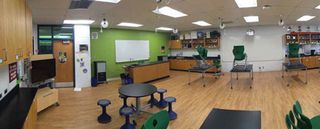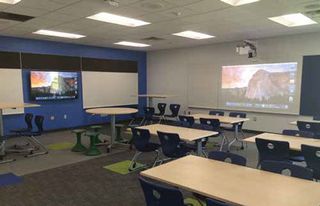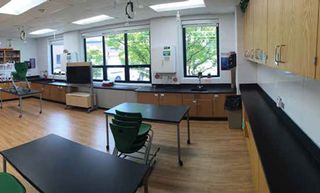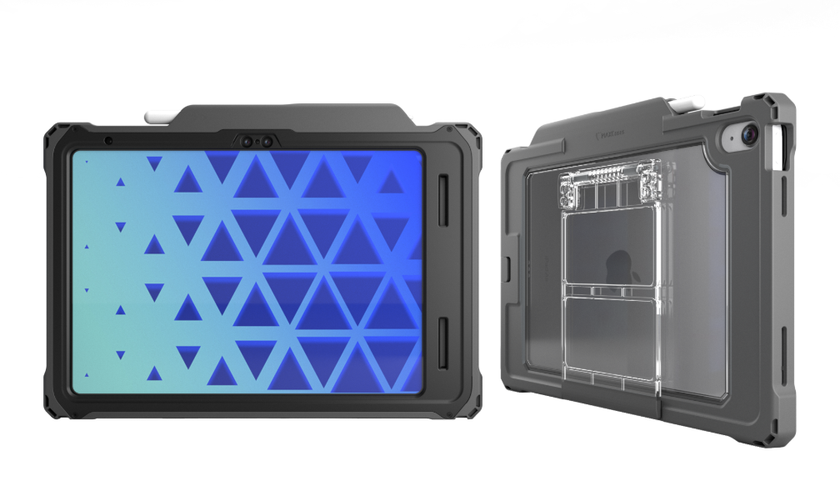Creating Collaborative Learning Spaces

The US Department of Education and the Illinois State Board of Education had already recognized our schools in Kildeer Countryside (IL) School District 96 for academic excellence. But district administrators recognized that we still needed to make significant changes to our classrooms and acquire better technology in order to help our students develop effective communication and collaboration—skills mandated by today’s educational standards. To that end, we turned our attention to redesigning classrooms to fit the learning needs of 21stcentury students. Here’s what we learned.
1 PHASE IN … DON’T RUSH IN
The science classroom at Kildeer Countryside (IL) School District 96. Three years ago, we began phasing in a 1:1 iPad program at Woodlawn Middle School and Twin Groves Middle School. But we noticed that traditional classrooms really didn’t provide the environment and flexibility necessary to successfully integrate 1:1 technology. Whether we arranged desks in traditional rows or mini-pods, it was difficult for kids to maneuver, share information, and collaborate with each other. So, in an effort to create a freer environment, the district began to phase in reconfigured classrooms. During the 2014–15 school year, we redesigned 10 classrooms—five rooms in each of the two middle schools. We tore walls down to the studs and remodeled from there. During the summer of 2015, the district completed renovations on 22 more classrooms, concentrating on our schools’ math and language arts classrooms.

2 FROM RESELLERS TO TECHNOLOGY PROVIDERS— KNOW THE COMPANY YOU KEEP
The math classroom at Kildeer Countryside (IL) School District 96. The district had worked in the past with Fathom Media, a reseller whose specialty is serving as an audiovisual integrator and partner. Drawing on its vast industry network and expertise, Fathom Media presented MimioProjector touch projectors as the best option to help the district accomplish its goal. That’s what partnering is about—the optimal execution of goals! We replaced our interactive projectors with the touch projectors, which turn conventional dry-erase boards into touch boards. Teachers and students can use their hands on those touch boards, instead of depending on styli, and the boards can respond to up to 10 touches at once. So more than one student can interact with the board at any given time, which is really one of the coolest features.

3 AROUND AND AROUND THE LEARNING GOES
Woodlawn’s newly-configured classrooms feature 270-degree visual surround, with two walls bearing 65-inch televisions in addition to the MimioProjector touch projector on a third wall. Each of these devices is connected to an Apple TV.
The classrooms are set up so that there’s really no front-of-the-classroom. Because the tables are on wheels, smaller groups working on projects collaboratively can adapt their workspaces. They can slide closer either to the projector or to one of the televisions. Then they can send what’s on their iPads to the television through the Apple TV and share it with the class.
4 RESULTS MATTER
Yes, there is increased student engagement in the new classrooms. Plus, teachers can now differentiate at a greater level with students and are better able to meet every student’s needs with the technology. And these improvements come not only from the new interactive environment but also from a huge shift in the teachers’ instructional practice. The district trains teachers in different strategies that help them to create a collaborative learning environment and to make sure that every student has a say. There’s no way a kid can hide in our classrooms anymore.

District educators have also noted that the new classrooms facilitate compliance with the Common Core State Standards, allowing teachers to delve more deeply into those standards. We’re able to make sure that students gain the thorough understanding that the standards require—especially those including communication and collaboration.
District 96 is now working on plans for the 2016–17 school year, which include redoing the rest of the middle schools’ science classrooms. And as before, we’ll stay focused on figuring out what will fit our students’ learning needs. In the end, it’s all about student learning.
Tech & Learning Newsletter
Tools and ideas to transform education. Sign up below.











